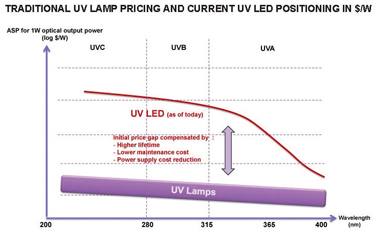
| Home | About Us | Contribute | Bookstore | Advertising | Subscribe for Free NOW! |
| News Archive | Features | Events | Recruitment | Directory |
| FREE subscription |
| Subscribe for free to receive each issue of Semiconductor Today magazine and weekly news brief. |
News
29 January 2009
UV LED market to grow to $250m in 2015
The annual market for traditional ultraviolet (UV) lamp technology is about $500m. But, due to their compactness, lower cost of ownership and environmental friendly composition, UV LEDs will replace them and also open up many new applications (especially portable ones), forecasts consulting firm Yole Développement in its ‘UV LED Market Report – 2009’, which is dedicated to UV LEDs based on gallium nitride (GaN) and aluminum nitride (AlN) technologies.

Graphic credit: Yole Développement.
In 2008, LEDs in the UV A/B spectrum were the dominant device in sub-400nm applications. More than 90% of the UV LED market (excluding R&D) consisted of UV curing, counterfeit detection, medical and instrumentation applications requiring UV A/B sources. The remaining 10% was for air and water purification, again consisting of a large portion of UV A-based LED sources for photocatalytic air purification.
Yole says that UVA (400–315nm light wavelength) currently dominates the UV LED market (with a market share of about 90% in 2008) and will continue to do so for at least the next four years (with about 70% market share in 2012).
Key applications for UVA are UV curing, document/banknote verification, photocatalyst air purifier, and medical phototherapy. Among those, the most dynamic and important UVA lamp market is UV curing, where UV LEDs are definitely able to compete with traditional mercury lamps. The market is large ($120m) and growing at about 10% annually due to the advantages of UV curing technology over traditional technology (e.g. speed). Consequently, many new players have emerged over the past five years at both the system and LED packaging levels. Also, the available power output has greatly increased, and several Watts/cm² will be available in 2009-2010, says Yole.
Two years ago there were high hopes for UVC applications (e.g. disinfection, purification), but real applications have still not materialized due to the significant technical and economic challenges for UV LEDs, i.e. power output, efficiency, lifetime and cost. Players in UVC technology are hence now focusing on UVA instead (see figure).
The first UVC LED applications are mostly for scientific analytical instruments. It is expected that the first large-scale sales for the disinfection market will appear in 2010, both on existing markets and also for new point-of-use or portable applications (where compactness is a key issue).
UVC market growth is strongly connected to the availability of AlN bulk substrates, which could theoretically multiply by 100 the optical power output of the LED chip, says Yole. Several players are expecting to provide AlN wafers in volume at the end of 2009. Hence, UVC LED applications based on AlN will probably reach the market in 2011-2012, forecasts Yole.
“We also observe a strong trend where AlN companies are now extending their activities to UV LEDs to capture more added-value along the supply-chain,” says the report’s author, Yole project manager Dr Philippe Roussel. According to the large potential for UVA LED business in UV curing, augmented by growing market demand for water and air disinfection, Yole forecasts that the total UV LED market will reach $250m in 2015.
Visit: www.yole.fr
